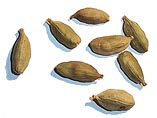Cardamom
|
|
| Cardamom | ||||||||||||
|---|---|---|---|---|---|---|---|---|---|---|---|---|
 Cardamom fruit as used as spice. | ||||||||||||
| Scientific classification | ||||||||||||
| ||||||||||||
| Binomial name | ||||||||||||
|
Elettaria cardamomum |
The name Cardamom is used for species within three genera in the Ginger family (Zingiberaceae), Elettaria, Amomum and Aframomum. Elettaria is distributed from India to W. Malaysia (commonly called Green cardamom or just Cardamom), Amomum mainly in Asia and Australia (Cardamom, Kravan, Java cardamom, Bengal cardamom, Siamese cardamom, White/Green/Red/Black cardamom, Guinea grains, Grains of paradise) and Aframomum in Africa and Madagascar (Cardamom, Madagascar cardamom).
The main uses for all the different cardamom species and varieties are as spices and as medicines (see below).
'True' Cardamom (Elettaria cardamomum) is a pungent aromatic spice and medicinal herb. It is a perennial plant that can grow to be between six and 12 feet tall. Cardamom can also be spelt Cardamon, and in India it is popularly known as elaichi. Other (trade names) are Green cardamom and Small cardamom.
The green seed pods of the plant are dried and the seeds inside the pod are used in Indian and Asian cuisine either whole or in a ground form. Ground Cardamom is a primary ingredient of curry powder. In the Middle East, Cardamom is used for coffee; in other countries such as Iran, it is used to flavor tea. Cardamom is also an ingredient of herbal teas from India, called "Yogi tea." The Indian state of Sikkim has the highest area under cultivation and production of the spice in India.
Cardamom-Dried-Seeds01.jpg
Elaichi.jpg
Cardamom was first used around 700 CE and was imported to Europe for the first time in around 1200. Originally from the tropical rainforest of India, Sri Lanka, Malaysia and Sumatra, it is now also grown in Nepal, Thailand, and Central America.
Cardamom has a strong, unique taste, with an intensely aromatic fragrance. It is often used in baking in Scandinavia. One of the most expensive spices by weight, little is needed to impart the flavor. Cardamom is best stored in pod form, as once ground, the seeds quickly lose their flavor.
| Contents |
Medicinal and other uses
In general Aframomum is used as a spice, Elettaria both as a spice and as medicine (and a masticatory), and Amomum used as an ingredient in several traditional medicines in China (TCM), India, Korea and Vietnam. Species in the genus Amomum is also used in India. Amomum villosum, and other species, varieties and cultivars is used in TCM to treat stomach-aches, constipation and other digestion problems, and also in treatment of dysentery. However, "Tsaoko" cardamom (Amomum tsao-ko) is cultivated in Yunnan (China) both for medicinal purposes and as a spice. Cardamom is also widely used in Korea, Thailand and Vietnam. In India large cardamom (A. subulatum) is more broadly (than in TCM?) used to treat infections in teeth and gums, to prevent and treat throat troubles, congestion of the lungs and pulmonary tuberculosis, inflammation of eyelids and also digestive disorders. It is also reported as used as an antidote for both snake and scorpion venom (bites). Elettaria species is used as a spice in meat dishes, such as hamburgers, but also in medicine and as a masticatory (i.e. it is smoked).
External links
- All about Cardamom (http://www.avalon.net/~slainte/cardamom.html)
- Cultivating and collecting Amomum in Lao PDR (pdf) (http://home.no.net/tkvitvik/cardamom.pdf)
- Photo of Cardamom (http://www.pbase.com/image/37164914)
References
Mabberley, D.J. (1996). The Plant-book: A Portable Dictionary of the Higher Plants. Cambridge University Press.
See also
Black cardamombg:Кардамон de:Kardamom eo:Kardamomo fr:Cardamome nl:Kardemom ja:カルダモン no:Kardemomme fi:Kardemumma sv:Kardemumma
